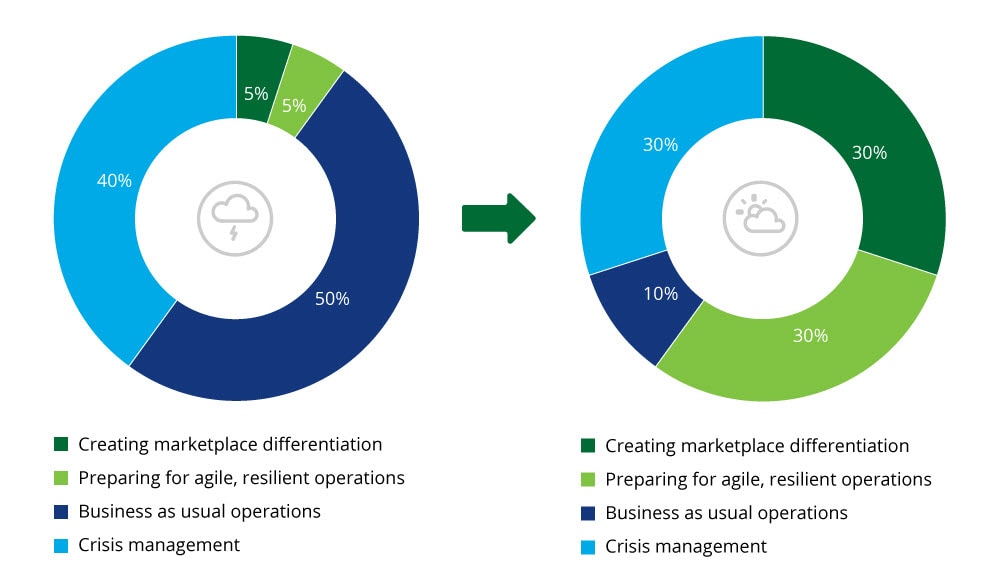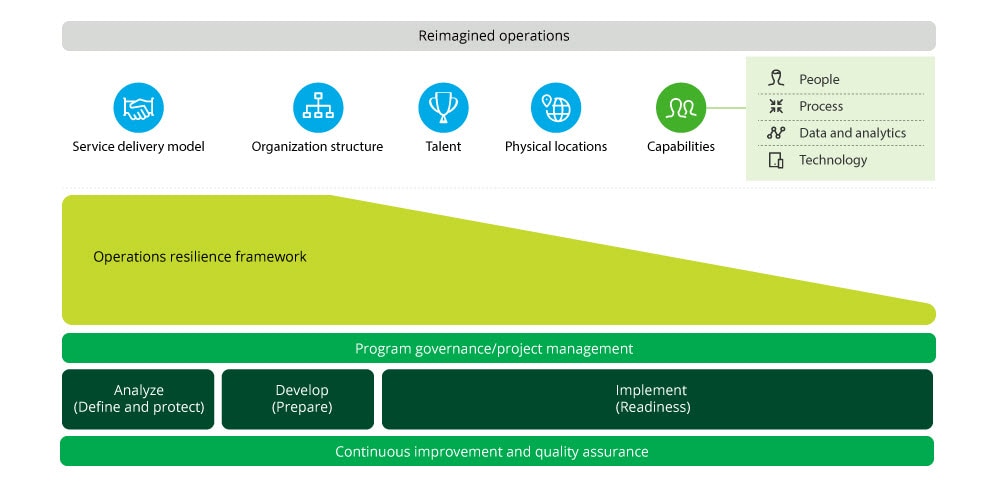COOs and the pandemic: Time to shift from defense to offense has been saved

Perspectives
COOs and the pandemic: Time to shift from defense to offense
COO Agenda
In today’s blog, we’ll discuss the increasingly important balance of time spent on offense vs. defense in the coming weeks.
Explore content
- Defense vs. offense—seeking a better balance
- A game plan for building operational resilience
- Sticking to the game plan (with agility)
- Get in touch
- Join the conversation
NCAA basketball coaching legend Bobby Knight reflected that coaches often talk about offense and defense, but rarely mention the equally important phase of the game: “Conversion from offense to defense and defense to offense.”1
When organizations confront disruptive events such as COVID-19, the COO is the coach, disaster recovery (DR) and business continuity planning (BCP) are the defense, and operational resilience is the offense. Operational resilience is agility that’s embedded in day-to-day operations, which is different than executing remediations after a crisis erupts—the primary focus of crisis recovery and business continuity. While timetables vary by industry and company, we expect a shift from defense to offense to begin in full force soon—if it hasn’t already happened.
In our last blog, we described operational resilience in the context of Deloitte’s Respond...Recover...Thrive framework (figure 1). In today’s blog, we’ll discuss the increasingly important balance of time spent on offense vs. defense in the coming weeks. We’ll offer a high-level framework for shifting more resources toward resilient offense going forward. And we’ll provide key considerations for that journey.
Figure 1. Deloitte’s Respond...Recover...Thrive framework

Defense vs. offense: Seeking a better balance
In our conversations with COOs across industries these past few weeks, we’ve talked with many who are spending the majority of their time on defense, as depicted hypothetically in the left half of figure 2, versus how they would like to be spending their time, per the right side of the figure.2
Figure 2. What COOs may be doing today vs. what they should be doing

Defensive activities (figure 3, left side) typically center on crisis management—for example, quickly putting in place a remote work strategy for large segments of the workforce or pulling levers of cost management to adjust for unexpected revenue fluctuations. At the same time, defense for many COOs means simply trying to maintain business as usual operations to the extent possible—likely a real challenge in today’s crisis environment. What we’ve also learned through hundreds of client conversations is that these actions were typically divorced from actual BCP and DR plans, unable to leverage real-time internal and external data effectively for important decisions, and difficult to clearly communicate to stakeholders.
Contrast that with a greater focus on offensive activities (figure 3, right side). These are forward-looking actions that can help grow the business with marketplace differentiation coming out of the crisis and instill operational resilience in preparation for potential future waves of the pandemic and other disruptions. This is certainly where we believe COOs would prefer to spend their time and efforts.
Figure 3. Types of defensives vs. offensive activities

A game plan for building operational resilience
For most organizations, now is the time to consider shifting to offense, embedding more resilience into operations. This shift includes revamping BCP and DR plans, governance, and processes and more importantly, redesigning operations to be more agile and appropriately balanced to mitigate risk. We are actively doing that by using a framework (figure 4) to help our clients reimagine fundamental operating model components with this concept in mind.
Figure 4. Operations resilience methodology

Analyze. Conducting risk and impact analyses to rapidly develop a clear understanding of “business-critical” processes and assets and prioritize how they’re addressed, both in business as usual operations and during a crisis. For clients with particularly pressing needs, we’re helping them expedite this process through a series of “Resilience Labs.”
Develop. Evaluating the resilience of those critical processes and assets, including buildings, equipment, technology, human resources, and third-party relationships (BETH3 methodology), through response and recovery planning. The goal is to develop an “all-hazards” capability, followed by high-impact, “scenario-specific” strategies and plans for response and recovery. This feeds into operating model redesign efforts that balance resilience with other mission-critical priorities such as experience, efficiency, and platforms for growth.
Implement. Deploying the redesigned operating model with the required agility built in. To infuse this capability into muscle memory, operational resilience requires both offensive and defensive practice, using techniques such as wargaming, simulations, and integrated testing and exercises. This preparation includes what to do, what decisions need to be made, and what kind of data is needed for effective decision-making. Underpinning this effort is also a defined resilience process, including innovative capabilities and the regular updates required for the strategies to be executable as your business changes.
Resilience in action
Hospitals and surgery centers across the United States have been, or soon will be, reopening for nonemergency and elective surgeries after being in lockdown for various periods. To fulfill health care’s Triple Aim of better care for individuals, better health for populations, and a lower per capita cost of care,[1] providers should first determine how to survive in the immediate aftermath of a severe economic and social disruption, as well as the potential for further disruptions in the coming months.
Many COOs at leading hospitals and surgery centers are therefore performing detailed analyses in preparation for the new normal, such as:
- Which service lines—that is, types of surgery—can help jump-start revenue most rapidly?
- Will patients who might have been scheduled for surgery prior to lockdown want to return and, if so, will they still have insurance?
- What refinements to long-accepted surgical practices might need to be made to accommodate new federal, state, or local requirements?
- What modifications might need to be made to the care continuum, both in the short term (the next two months) and the long term to protect patients and frontline care providers?
- How can all of these changes be made with speed and agility, and how can the organization be prepared to make equally agile changes going forward if a second wave of the pandemic or other disruptions emerge?
COOs in other industries should be asking similar questions up front—obviously tailored to the type of business and work environment they lead—as they develop their “restart” plans and begin to reshape their work, workforce, and workplace to be more agile and resilient going forward. Included in these plans should be considerations for factors such as a more decentralized workforce, greater cyber vulnerabilities, different regulations, and financial variables.
Sticking to the game plan (with agility)
At the end of the day, operational resilience is about being a better, more agile business—and staying that way even in the face of inevitable disruptions. This can happen when you build resilience into your operations rather than on top of them. It doesn’t diminish DR or BCP planning; in fact, they are more important than ever. It simply embeds them, with effective governance, into the heart of your business. Doing so will require COOs to evolve along with their teams and business-as-usual operations. In our next installment of COOs and the pandemic, we’ll offer insights on how the COO role is likely to change in the wake of the pandemic and how you can be an even better coach to your organization going forward.
Key considerations for your organization’s journey to operational resilience
- Keep it simple—don’t form too many taskforces or committees with no predefined or conflicting agendas.
- Focus on “what” outcomes are to be delivered before deciding “how” to deliver them.
- Make decisions with agility.
- Leverage your organization’s enterprise risk management capabilities to establish and prioritize operational risks and help model disruptive scenarios.
- Establish well-defined risk tolerances, and don’t accept or avoid operational risks that exceed them.
- Give data its due—make sure data used for resilience planning and execution is current, accurate, and from reliable sources and account for upstream and downstream dependencies.
- Make sure impact analyses and resilience tests and exercises evolve with changing business, ecosystem, and economic conditions.
COOs and the pandemic: Operational resilience is imperative
Article 1: COOs and the pandemic: Shape a more resilient future
Article 2: COOs and the pandemic: Time to shift from defense to offense
Article 3: COOs and the pandemic: Finding the right balance as your role changes
Recommendations
Welcome to the COO Agenda
Sharing perspectives and insight on operational excellence practices chief operating officers are leading today





